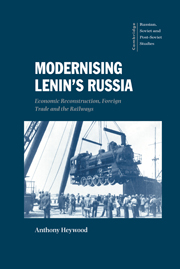Book contents
- Frontmatter
- Contents
- List of illustrations
- List of tables
- Acknowledgements
- Technical note
- List of abbreviations and acronyms
- Introduction
- PART I Towards economic reconstruction, 1917–1920 the birth of the railway imports policy
- PART II Trade and isolation, 1920–1921 implementing the railway imports policy
- PART III Retreat, 1921–1924
- Conclusion
- Notes
- Bibliography
- Index
- Cambridge Russian, Soviet and Post-Soviet Studies
- Plate Section
Conclusion
Published online by Cambridge University Press: 14 August 2009
- Frontmatter
- Contents
- List of illustrations
- List of tables
- Acknowledgements
- Technical note
- List of abbreviations and acronyms
- Introduction
- PART I Towards economic reconstruction, 1917–1920 the birth of the railway imports policy
- PART II Trade and isolation, 1920–1921 implementing the railway imports policy
- PART III Retreat, 1921–1924
- Conclusion
- Notes
- Bibliography
- Index
- Cambridge Russian, Soviet and Post-Soviet Studies
- Plate Section
Summary
The railway imports policy was part of a general strategy to kick-start rapid economic reconstruction and modernisation in 1920 by concentrating resources on the transport sector, primarily the railways. Though the prospects for foreign trade were uncertain, the NKPS imports plan had unprecedented targets of 5,000 new locomotives and 100,000 wagons, and it won a staggering 40 per cent of the gold reserve for initial orders. Its grandiosity epitomised the tremendous but naive optimism with which the Bolshevik leadership addressed economic policy at the beginning of 1920, when Lenin spoke of overcoming the economic crisis and beginning to build a modern socialist industrial economy within only a few months. This general strategy collapsed by 1921, but the allocation of so much gold did ensure that, despite later financial cutbacks, the railway imports policy played a major role in the expansion of Soviet–Western trade in 1920–1, and in the revitalisation of the Soviet railways.
The complex roots of this policy included decisions made before and during the First World War as well as planning during the civil war. But little would have happened without the Soviet government's willingness to assign 300 million gold rubles for it in March 1920. This book has argued that this unique decision is explained by – and dramatically demonstrates – the Bolshevik leadership's determination to embark immediately on rapid economic recovery, modernisation and development within the framework of War Communism.
- Type
- Chapter
- Information
- Modernising Lenin's RussiaEconomic Reconstruction, Foreign Trade and the Railways, pp. 225 - 234Publisher: Cambridge University PressPrint publication year: 1999

